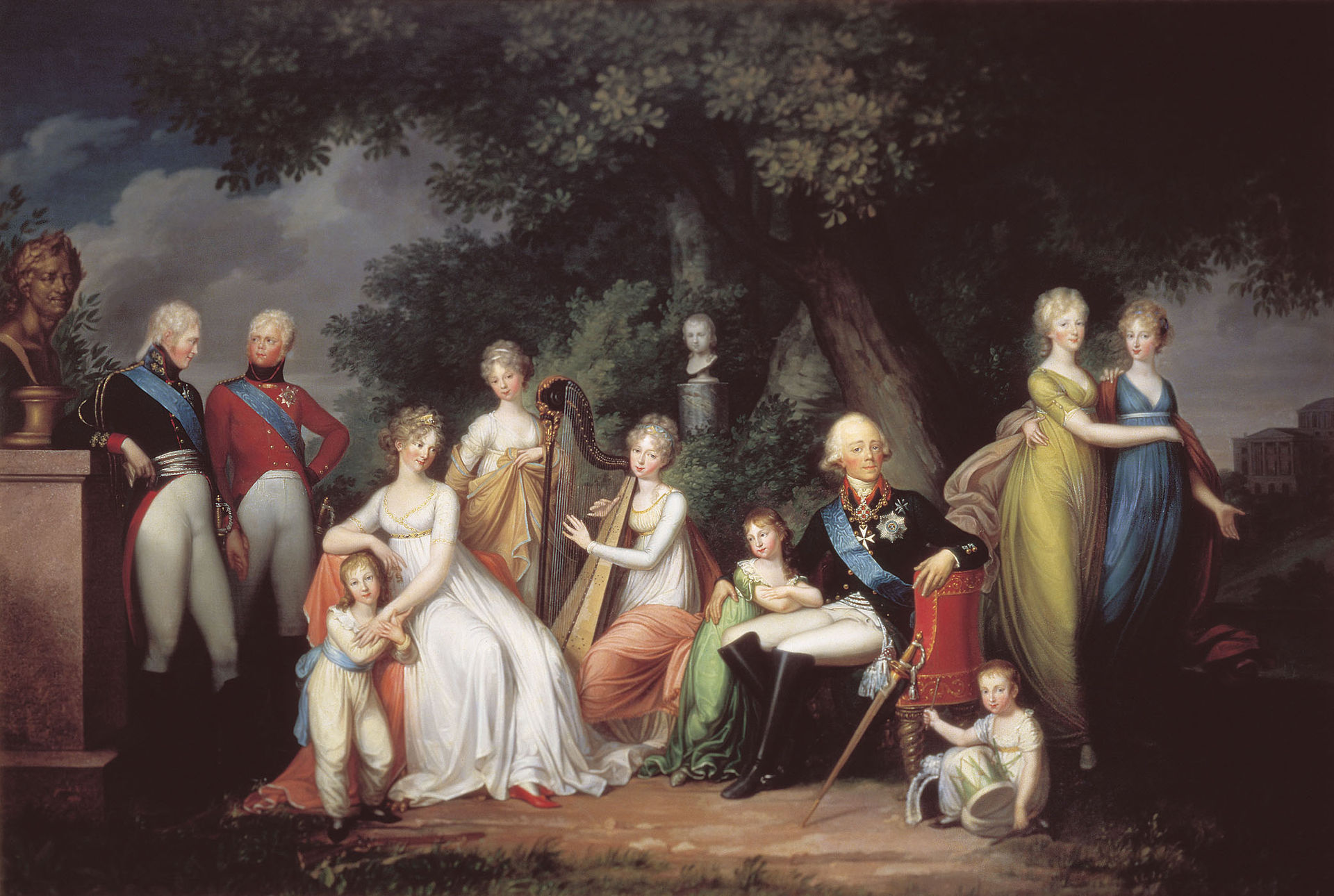by Scott Mehl
© Unofficial Royalty 2017

Maria Pavlovna of Russia, Grand Duchess of Saxe-Weimar-Eisenach; source: Wikipedia
Maria Pavlovna of Russia was the wife of Grand Duke Karl Friedrich of Saxe-Weimar-Eisenach. She was born at Pavlovsk Palace in St. Petersburg, Russia on February 16, 1786, the daughter of Paul I, Emperor of All Russia and his second wife Sophie Dorothea of Württemberg.

Paul I of Russia and his family. Maria is depicted in the center, playing the harp. source: Wikipedia
Maria had nine siblings:
- Alexander I, Emperor of All Russia (1777 – 1825), married Luise of Baden (Elizabeth Alexeievna), had two daughters who both died in childhood
- Grand Duke Konstantine Pavlovich (1779 – 1831), married (1) Juliane of Saxe-Coburg-Saalfeld (Anna Feodorovna), no children, marriage annulled (2) Joanna Grudzińska, no children, a morganatic marriage that cost Constantine the crown
- Grand Duchess Alexandra Pavlovna (1783 – 1801), married Archduke Joseph of Austria, Count Palatine of Hungary, had one daughter who died at birth, Alexandra died of childbirth complications a week later
- Grand Duchess Elena Pavlovna (1784 – 1803), married Friedrich Ludwig, Hereditary Grand Duke of Mecklenburg-Schwerin, had two children
- Grand Duchess Catherine Pavlovna (1788 – 1819), married (1) Georg of Oldenburg, had two sons (2) King Wilhelm I of Württemberg, had two daughters including Sophie who married King Willem III of the Netherlands
- Grand Duchess Olga Pavlovna (1792 – 1795), died in early childhood
- Grand Duchess Anna Pavlovna (1795 – 1865), married King Willem II of the Netherlands, had five children including King Willem III of the Netherlands
- Nicholas I, Emperor of All Russia (1796 – 1855), married Charlotte of Prussia (Alexandra Feodorovna), had ten children including Alexander II, Emperor of All Russia
- Grand Duke Michael Pavlovich (1798 – 1849), married Charlotte of Württemberg (Elena Pavlovna), had five children

Karl Friedrich of Saxe-Weimar and Saxe-Eisenach. source: Wikipedia
After the marriages of her two elder sisters, the focus turned to finding a suitable husband for Marie. By 1800, there were already discussions about a marriage to the Saxe-Weimar heir, Karl Friedrich. The two met in July 1803 when he came to St. Petersburg, and after getting acquainted and spending time together, their engagement was announced.
Maria married Karl Friedrich, then the Hereditary Duke of Saxe-Weimar and Saxe-Eisenach, at the Grand Church of the Winter Palace in St. Petersburg, Russia on August 3, 1804. In May of the following year, they returned to Weimar and were greeted with great celebrations.
The couple had four children:
- Prince Paul Alexander (1805-1806) – died in infancy
- Princess Marie Luise (1808-1877) – married Prince Karl of Prussia, had issue
- Princess Augusta (1811-1890) – married Wilhelm I, King of Prussia and Emperor of Germany, had issue
- Karl Alexander, Grand Duke of Saxe-Weimar-Eisenach (1818-1901) – married Princess Sophie of the Netherlands, had issue

Grand Duchess Maria in later life. source: Wikipedia
Maria strongly supported and promoted the arts in Weimar, and her patronages included the noted composer Franz Liszt who was appointed to her court. She maintained lifelong correspondences with several prominent writers, poets, and musicians, including Vasily Zhukovsky, Johann Wolfgang von Goethe, and Friedrich Schiller. She also focused much of her efforts on social welfare, establishing hospitals and homes for the poor and unwell. She also helped to establish the Falk Institute in Weimar.

The Russian Orthodox Chapel (with the Weimarer Fürstengruft seen behind it). photo: by © R.Möhler – Originally posted to Panoramio as Russisch-Orthodoxe Kapelle, CC BY-SA 3.0, https://commons.wikimedia.org/w/index.php?curid=5252819
Following her husband’s death in 1853, Maria retired from public life. Two years later, she returned to Russia for the last time, for the coronation of her nephew Alexander II, Emperor of All Russia. The Dowager Grand Duchess died at Schloss Belvedere in Weimar, Grand Duchy of Saxe-Weimar-Eisenach, now in the German state of Thuringia, on June 23, 1859. A new Russian Orthodox Chapel was built adjoining the Weimarer Fürstengruft in the Historical Cemetery in Weimar. In the early 1900s, the foundation wall between the two buildings was opened, creating a passageway. Grand Duchess Maria’s tomb lies in this passageway, just next to her husband’s, each placed beneath their individual mausoleums.

Maria Pavlovna’s tomb in the far back on the left, in the area where the foundation was excavated. Just in front of her tomb is the tomb of her husband. photo: Klassic Stiftung Weimar
This article is the intellectual property of Unofficial Royalty and is NOT TO BE COPIED, EDITED, OR POSTED IN ANY FORM ON ANOTHER WEBSITE under any circumstances. It is permissible to use a link that directs to Unofficial Royalty.
Saxe-Weimar-Eisenach Resources at Unofficial Royalty
